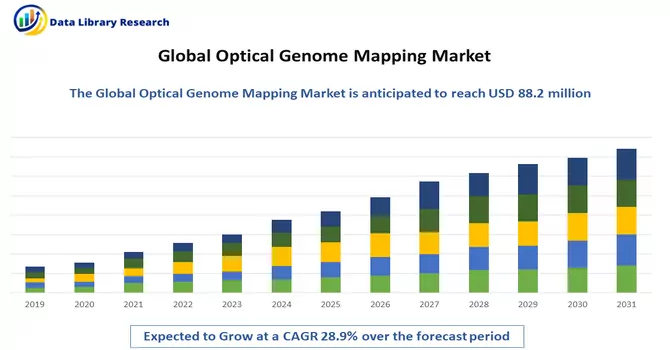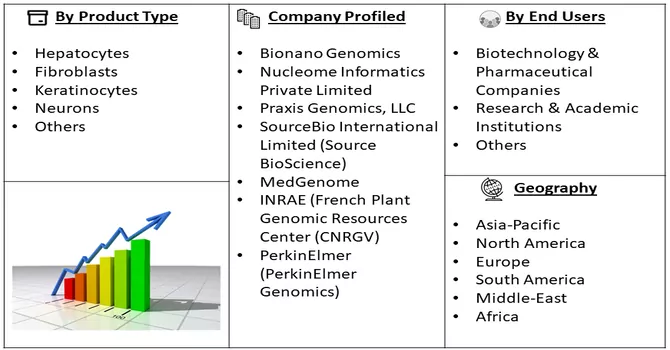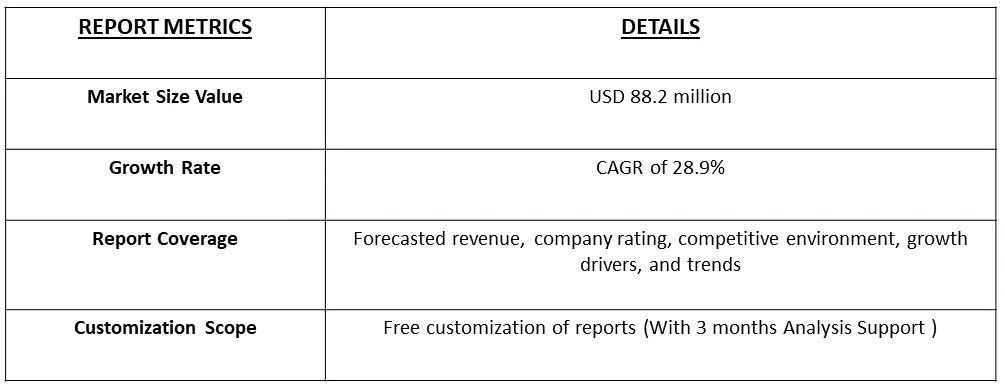In 2022, the global optical genome mapping market was assessed at USD 88.2 million, and it is anticipated to experience robust growth with a compound annual growth rate (CAGR) of 28.9% from 2023 to 2030.

Get Complete Analysis Of The Report - Download Free Sample PDF
Optical genome mapping is a genomic technology that provides a high-resolution, long-range view of the structure and organization of an organism's genome. It is a powerful molecular biology technique that enables the comprehensive analysis of DNA at a large scale. The primary goal of optical genome mapping is to map the entire genome, identifying structural variations, large-scale rearrangements, and other genomic features.
This substantial expansion is largely attributed to the rising need for sophisticated genomic analysis tools and methodologies. The heightened demand stems from the pivotal role that optical genomic mapping plays in providing researchers and clinicians with a potent approach to investigate structural variations within the genome. This capability enhances their comprehension of genetic diseases and facilitates the advancement of personalized medicine. The trajectory indicates a dynamic and flourishing market as the scientific community increasingly recognizes the significance of optical genome mapping in advancing genomics research and its applications in healthcare.
The optical genome mapping market is characterized by continuous technological advancements, including improvements in imaging techniques, labeling technologies, and data analysis algorithms. These innovations aim to enhance the accuracy, resolution, and efficiency of optical genome mapping, driving market growth. There is a growing trend toward the adoption of optical genome mapping in clinical diagnostics. The technology's ability to identify structural variations and large-scale genomic rearrangements makes it valuable for diagnosing genetic diseases and understanding their underlying mechanisms, supporting the trend of personalized medicine. Moreover, there is a noticeable trend in the application of optical genome mapping in plant genomics research. The technology is proving valuable for studying the genomes of agriculturally important crops, aiding in crop improvement and breeding programs.
Market Segmentation: The Optical Genome Mapping Market is segmented by Product Type (Instruments (Optical Genome Mapping Instrument), Consumables), End Users (Biotechnology & Pharmaceutical Companies, Research & Academic Institutions, Others), Geography (North America, Europe, Asia-Pacific, Rest of World). The report offers the value (in USD million) for the above segments.

For Detailed Market Segmentation - Download Free Sample PDF
Market Drivers:
Rapidly Increasing Bio-Pharmaceutical Advances in Drug Development Coupled with Government Funding
The global optical genome mapping market is experiencing a significant boost, fueled by the rapidly increasing advances in bio-pharmaceuticals and drug development, complemented by substantial government funding. This synergy has created a dynamic landscape where cutting-edge genomics technologies, such as optical genome mapping, play a pivotal role in revolutionizing drug discovery and personalized medicine. In addition, numerous strategic initiatives help market participants to strengthen their industry position. For instance, in March 2023, Bionano Genomics launched two novel OGM-based clinical tests, OGM-Dx prenatal whole genome structural variant and OGM-Dx postnatal whole genome structural variant.
Furthermore, the integration of optical genome mapping into drug development processes has become instrumental in identifying and validating therapeutic targets. By providing high-resolution views of genomic structures, the technology aids in characterizing genetic variations associated with diseases. This precision enhances the drug discovery pipeline by offering insights into potential biomarkers, improving target identification, and optimizing the development of therapeutic interventions. The result is a more efficient and informed drug development cycle. Thus, the above-mentioned factors are expected to drive the growth of the studied market over the forecast period.
Cost-effectiveness and Accuracy
Optical genome mapping provides high-resolution genomic maps, allowing for accurate and detailed analysis of structural variations. The technology's ability to capture large-scale rearrangements with precision contributes to a more thorough understanding of genomic architecture, ensuring accurate identification of relevant genomic alterations.
Moreover, the burgeoning government initiatives in genome mapping are propelling market growth. A noteworthy example is the endorsement of the "GenomeIndia: Cataloguing the Genetic Variation in Indians" project by the Government of India, Ministry of Science & Technology, in March 2020. This initiative, centered on Whole Genome Sequencing (WGS), is slated to encompass 10,000 individuals over three years, representing the diverse genetic makeup of the country's population. Notably, optical genome mapping laid the groundwork for whole-genome sequencing, with sequenced DNA fragments aligned to the genome map to facilitate genome assembly. Thus, such instances are expected to drive the growth of the studied market over the forecast period.
Market Restraints
Lack of Skilled Technicians & Complex Procedures
The operation and interpretation of sophisticated genome mapping technologies require a high level of technical expertise. There is a shortage of skilled technicians proficient in handling the intricacies of these advanced genomic tools. The complexity of the equipment and the need for precise execution of protocols contribute to a scarcity of trained professionals, hindering the efficient utilization of genome mapping technologies. Moreover, genome mapping involves intricate procedures such as sample preparation, sequencing, data analysis, and interpretation. The complexity of these processes poses a significant challenge, especially in laboratories or research facilities with limited expertise. The intricacies involved in handling diverse genomic data and ensuring accurate results contribute to the slow adoption of genome mapping technologies. Thus, such factors are expected to slow down the gowth of the studied market over the forecast period.
In the initial stages of the COVID-19 pandemic, the optical genome mapping market experienced a substantial impact due to the rapid and unforeseen spread of the virus. An article titled "Host Genome Analysis of Structural Variations by Optical Genome Mapping Provides Clinically Valuable Insights into Genes Implicated in Critical Immune, Viral Infection, and Viral Replication Pathways in Patients with Severe COVID-19," published by medRxiv in 2021, underscores the potential of optical genome mapping in elucidating the inter-individual variability associated with SARS-CoV-2 infections and COVID-19 mortality. According to the findings, optical genome mapping emerges as a potent tool for comprehending large structural variations (SV) that influence clinical outcomes in severe COVID-19 cases. This technology plays a crucial role in recognizing specific genomic variations linked to patient survival rates, offering valuable insights beyond what is provided by existing sequencing-based technology databases. The article emphasizes the significance of optical genome mapping in enhancing our understanding of the genetic factors influencing the severity of SARS-CoV-2 infections, thereby contributing to more informed clinical decision-making during the ongoing global health crisis.
Segmental Analysis:
Reagents and Consumables Segment is Expected to Witness Significant Growth Over the Forecast Period
Reagents and consumables are integral components of the optical genome mapping workflow, playing a crucial role in ensuring the accuracy, efficiency, and success of genomic analyses. These essential materials contribute to sample preparation, labeling, and imaging processes, facilitating the extraction and analysis of genomic information through optical genome mapping technologies. Reagents utilized in sample preparation are fundamental to the success of optical genome mapping. This includes DNA extraction kits, purification reagents, and buffers designed to isolate high-quality genomic DNA from biological samples. The effectiveness of sample preparation directly impacts the quality of genomic data obtained during subsequent optical genome mapping procedures. Thus, the segment is expected to witness significant growth over the forecast period.
Pharmaceutical and Biotechnology Companies Segment is Expected to Witness Significant Growth Over the Forecast Period
Pharmaceutical and biotechnology companies play a pivotal role in shaping the landscape of the optical genome mapping market. The integration of optical genome mapping technologies within these industries has transformative implications for drug discovery, precision medicine, and advancements in genomics research. Pharmaceutical companies leverage optical genome mapping to expedite drug discovery processes. The technology's ability to provide high-resolution, long-range genomic information aids in identifying potential drug targets, understanding genetic factors associated with diseases, and optimizing therapeutic interventions. This accelerates the drug development pipeline, potentially leading to more efficient and targeted treatments. Thus, due to such advances, the segment is expected to witness significant growth over the forecast period.
North America Region is Expected to Witness Significant Growth Over the Forecast Period
North America dominated the optical genome mapping market, capturing the majority of the market share, as the region's leading position was attributed to significant advancements in genetic research, establishing it as a hub for innovation. The Tedtallk Podcast by the United States Food and Drug Administration (FDA) in 2021, focused on "Whole Genome Sequencing in the New Era of Smarter Food Safety," shed light on the increasing adoption of whole-genome sequencing in both the public and private sectors, particularly for enhancing food safety. Whole-genome sequencing (WGS) emerged as a cutting-edge technology, actively utilized by the FDA for novel and health-promoting applications. The podcast highlighted how WGS, coupled with optical genome mapping, has revolutionized the understanding of an organism's entire DNA makeup. This technological synergy allows the FDA to discern variations within and between species with unparalleled precision, surpassing the capabilities of existing technologies.
Moreover, the strong market presence in North America is further propelled by the active involvement of manufacturers and the introduction of key products. A notable ongoing clinical trial in 2022, titled "Validation of Optical Genome Mapping for the Identification of Constitutional Genomic Variants in a Postnatal Cohort," is sponsored by Bionano Genomics, a California-based company. The trial's objective is to leverage Optical Genome Mapping (OGM) using the Bionano Genomics Saphyr system to detect genomic structural variants (SVs) in human DNA. Thus, the above-mentioned factors are expected to drive the growth of the studied market.

Get Complete Analysis Of The Report - Download Free Sample PDF
Major players in the global optical genome mapping market are actively pursuing diverse strategic initiatives to reinforce their market presence. These initiatives include technological advancements, mergers and acquisitions, and collaborations aimed at enhancing their industry standing. Here are some key participants in the optical genome mapping market:
Recent Developments:
1) In February 2022, Arima Genomics introduced two groundbreaking products under the names Arima-HiC+ FFPE kits. These tools empower scientists to delve into their 3D genomic data, facilitating the identification and exploration of structural variants. By merging structural variant detection with 3D genome orientation information, researchers can gain a more comprehensive understanding of how these variants impact gene and cellular functionality. Ultimately, this enhanced insight is expected to aid scientists in uncovering novel disease mechanisms and identifying potential therapeutic targets.
2) In a separate development in October 2021, Bionano Genomics made a significant move by acquiring BioDiscovery, a leading software company renowned for its cutting-edge solutions in the analysis, interpretation, and reporting of genomics data. This strategic acquisition positions Bionano Genomics to collaborate closely with the BioDiscovery team in the development of an updated version of NxClinical. The envisioned version will seamlessly integrate optical genome mapping data with existing data types from next-generation sequencing and microarray technologies. Future objectives include expanding the platform's capabilities to encompass RNA expression profiling, delve into epigenetics, including methylation, and potentially incorporate proteomics data in subsequent iterations. This collaborative effort aims to provide researchers with a comprehensive and integrated tool for genomics data analysis, fostering advancements in various areas of molecular research.
Q1. What was the Optical Genome Mapping Market size in 2022?
As per Data Library Research the optical genome mapping market was assessed at USD 88.2 million.
Q2. At what CAGR is the Optical Genome Mapping Market projected to grow within the forecast period?
Optical Genome Mapping Market it is anticipated to experience robust growth with a compound annual growth rate (CAGR) of 28.9% over the forecast period.
Q3. Which Region is expected to hold the highest Market share?
North America region is expected to hold the highest Market share.
Q4. Who are the key players in Optical Genome Mapping Market?
Some key players operating in the market include
Data Library Research are conducted by industry experts who offer insight on industry structure, market segmentations technology assessment and competitive landscape (CL), and penetration, as well as on emerging trends. Their analysis is based on primary interviews (~ 80%) and secondary research (~ 20%) as well as years of professional expertise in their respective industries. Adding to this, by analysing historical trends and current market positions, our analysts predict where the market will be headed for the next five years. Furthermore, the varying trends of segment & categories geographically presented are also studied and the estimated based on the primary & secondary research.
In this particular report from the supply side Data Library Research has conducted primary surveys (interviews) with the key level executives (VP, CEO’s, Marketing Director, Business Development Manager and SOFT) of the companies that active & prominent as well as the midsized organization
FIGURE 1: DLR RESEARH PROCESS

Extensive primary research was conducted to gain a deeper insight of the market and industry performance. The analysis is based on both primary and secondary research as well as years of professional expertise in the respective industries.
In addition to analysing current and historical trends, our analysts predict where the market is headed over the next five years.
It varies by segment for these categories geographically presented in the list of market tables. Speaking about this particular report we have conducted primary surveys (interviews) with the key level executives (VP, CEO’s, Marketing Director, Business Development Manager and many more) of the major players active in the market.
Secondary ResearchSecondary research was mainly used to collect and identify information useful for the extensive, technical, market-oriented, and Friend’s study of the Global Extra Neutral Alcohol. It was also used to obtain key information about major players, market classification and segmentation according to the industry trends, geographical markets, and developments related to the market and technology perspectives. For this study, analysts have gathered information from various credible sources, such as annual reports, sec filings, journals, white papers, SOFT presentations, and company web sites.
Market Size EstimationBoth, top-down and bottom-up approaches were used to estimate and validate the size of the Global market and to estimate the size of various other dependent submarkets in the overall Extra Neutral Alcohol. The key players in the market were identified through secondary research and their market contributions in the respective geographies were determined through primary and secondary research.
Forecast Model
